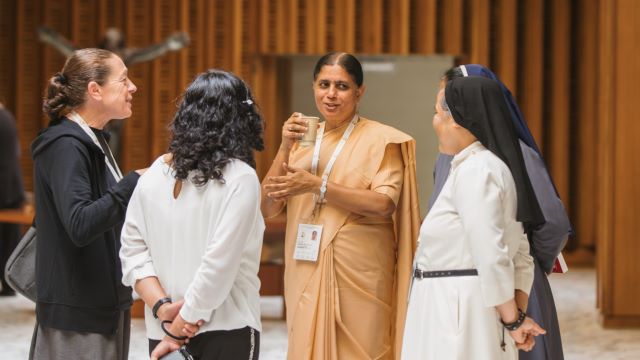Spiritual points by sr. Maria Grazia Angelini O.S.B
8ième Congregation générale – 13 octobre 2023
“And they remembered his words, and returning from the tomb they told all these things to the eleven and to all the rest.” Lk 24:8
Co-responsibility in Mission towards a shared awareness of the meaning and content, How can we better share gifts and tasks in the service of the Gospel. Instrumentum Laboris,. B 2.3
How can the Church of our time better fulfil its mission through greater recognition and promotion of the baptismal dignity of women? It is not a question of promotion and recognition in the worldly sense, of rights and desires, but of the well-being of the Church. In fidelity to the Origin, who is Jesus, his style, his words, his silences, his choice.
The Gospel is inspiring: and, also for these Synodal days, first and foremost beginning with the Eucharist. Celebrating in faith is the generative womb of every reform in the Church. And so, today’s passage (inseparable from tomorrow’s), at a critical point in Jesus’ communication with the crowd, in the midst of the conflict of interpretations, introduces, interwoven with Jesus’ words (“as Jesus said these things, …”), a woman cried out. Disruptive, the cry of a woman from the crowd who is touched by Jesus’ revelation and – inspired, because she does not know – perhaps using a popular saying, she proclaims the “beatitude of the womb.” It is an admirable correspondent to the blessing proclaimed at the beginning of the Gospel by another woman, there too in response to the sign picked up from the womb (Lk 1:45: “Blessed is the fruit of your womb…!”), “Blessed is the womb…!” she says. The anonymous woman in the crowd senses that in that man, the Rabbi of Nazareth who makes speak the one who was possessed by a demon that was mute, the generation of every life depends. She perceives the original mystery of generation that is revealed in him. She perceives, she cries out, but she does not know what to say, and so implicitly invokes what prompted her intuition.
And, picking up on her visceral intuition, Jesus develops it by transforming it and decodes its irruption: and that undoes the conflict of interpretations that were besieging him. He develops what is only an outcry, questioning astonishment: in the humanity of Jesus, God speaks, and that human person generated from a womb, is involved in his mystery.
“It is not flesh or blood” (cf. Mt 16:17; cf. Lk 8:21), he had already told Simon – to another cry of faith. Without refuting the woman of the people, he corrects her, deriving truth from it thus silencing, the insinuation of his adversaries: beatitude is in listening, welcoming, creativity, to him. To listen, to understand, to give flesh to the Word, the Word that was generated in the beginning.
Thus, the lightning-quick dialogue between Jesus and the anonymous woman in the crowd is full of symbolic, inspiring power. And, from there, from this humble prophetic voice – welcomed and dismantled, rather re-expressed – Jesus can resume his painful journey to Jerusalem, amidst insidious suspicions and the wonder of the little ones.
It is somewhat similar to what happened at Cana, with the cry of the mother which Jesus interrogates and transforms, “They have no wine” (or with the Samaritan woman, or with the Canaanite woman, or with Mary of Magdala).
This Gospel, from its luminous margins, powerfully evangelizes the inquisitive gathering of this Synod regarding the theme of mission and how to recognize different expressions of ministries. That anonymous woman’s cry, in its humility exorcises verbalism and proceduralism. It raises fruitful questions and clears the way: “Those who hears the Word and keep it.”
And light, in a convergent sense, seems to me to come if we compare this Gospel passage with the account of that critical passage of the apostolic church (Acts 16) in which, in the disorientation of the missionaries’ plans, crossed by the irruption of the Spirit, the Gospel enters Europe. And it opens up unprecedented fruitfulness to the mission, thanks to the humble, generative contribution of women. Are they merely extras? No, simply “grasped by the Word,” they open unseen spaces to the Gospel.
The Council of Jerusalem had just taken place (Acts 15), the ways of the gospel began to radiate beyond the land of Israel, not without bumpy paths. Immediately, following the first missionary journey, bitter disagreements irrupt between Paul and Barnabas, though they were soul friends. A controversial discernment over the presence of young Mark led to a parting of their ways (Acts 15:36-40). We must imagine a process of struggling to understand. Difference – even to the point of conflict – however necessary and fruitful in the Church, nevertheless differs from quarrelsome and poisoned contrast because it never demonizes the opponent, but makes room for him. Having separated paths, Paul and his co-workers[1] later face unforeseen obstacles or rather, as the book of Acts expresses it, “the Holy Spirit forbade them to proclaim the word in Asia” (Acts 16:6). Pope Francis reminded us in the opening homily of this Synodal Assembly, “So many missionary plans that end up in what appear to be blind, are in reality the crisis that opens new visions of Church.”
At Troas, a port, the point of departure to reach Europe, Paul has a vision: a Macedonian who begs him, saying, “Come over to Macedonia and help us.” The pagan’s cry hijacks, converts Paul’s plans. This is not the first time this change of itinerary happens by a Breath from above. The dream, the passivity and restlessness of the dream, of the startling vision, opens totally new vistas. It leads to conflicts, it opens horizons. Thus begins the second missionary journey. Starting from disorienting premises.
And so the Church lands in Europe, and it does so in a surprising, new form: starting from the margins, from the banks of the river, just outside a wealthy Roman city. “…women had gathered there for prayer.” Strangely, a liturgy outside the ritual, among women, in the open air, welcomed Paul. The apostle did not start here, as was his custom, in the synagogue (one probably did not exist in Philippi, a Roman colony). He inserted himself into a “non ritual” female liturgy, breaking into it with the word of the Gospel.
As on Easter morning, so too this beginning/threshold lacks men. The apostle is preceded, and welcomed, by the unusual koinonia of women praying, under the open sky. Here Paul lands, with his passion for the Gospel.
Thus began the course of the Gospel in Europe. In Philippi, mission emerged from a well-defined territory, and found new spaces. New languages inaugurated by women, whom Paul does not disdain, whom he rather gathered as a kairos: he preached to them, entered into dialogue. Lydia, humble worshipper of God and dealer of purple fabric, would become the first believer in the land of Europe.
Lydia is identified by her essence as a “hearer” of the Word – a dialogic, free and creative docility: she keeps the Word by seeking recognition from the apostle by offering hospitality: “If you have judged me to be faithful to the Lord, come”: a splendid inclusiveness of gifts that generates the Church. The apostle’s power of discernment before the simple openness of a heart opens new vistas for mission.
And so Lydia offers her home to the apostles, “prevailing on” them to accept (16:15). On this threshold, the Church in Europe is born, through a gesture that springs up as a way of putting into practice the faith (“if you have judged me to be a believer”), and offers the space of her domus (“come to my house and stay”).
Lydia’s house is thus redesigned by the irruption of the Gospel. As Jesus had done and commanded: entering whatever city, find a home (cf. Mt 10:11). Space constructed by bonds rather than walls. The basic ecclesial space, the “domus” that today powerfully begs to be rediscovered and articulated in new languages, according to its original wisdom.
The birth of a church in Europe evokes the original story. It recalls the novelty – how much is this grasped and understood today? – inaugurated by Jesus with those women who followed him, supporting his ministry out of their means (it is Luke again who tells us this: Lk 8:1-3): all the way to the cross, to the open tomb, and to the garden. On the third day…
The movement originated by the Gospel, and the soul of every true synodal journey, generates new, generative relationships. And the contribution of women, who are extremely diverse among themselves, (the woman of the people, the businesswoman of Cyrene…), unceasingly fuels the spiritual dynamism of reform – when the pattern becomes inadequate to the mystery it conveys. Vatican II inaugurated a reform movement that has been interrupted.
In the light of the Beginnings, Jesus’ style – that seems to comprehend that women are dynamic elements of mission, like a presence that in critical passages, passages that create a break, unsettling passages – senses the movement of life, weaves new, unlikely relationships, patiently creates and dissolves conflicts. It is not a matter of rights but of gifts received.
For mission, therefore, there are different diakonias. In each case, an “outgoing” synodal Church, in the beginning as today, immediately encounters the presence of women, various and diverse women, not to be homologated – to be discerned (“if you have judged me to be…”), certainly, and to be integrated based on the particularity of each. This is the evidence of the Word. The element inscribed in generative roots, as a constitutive trait of evangelical newness, disregarded for centuries. In his way of relating to women, Jesus was innovative, he created a risky and revelatory style, but this peculiarity has provocative validation in the temper of present reality. Today we find ourselves in the concrete situation of realizing that this regards us, it regards the Church that seeks reform.
To go out and proclaim the coming of the Kingdom, Jesus says “the home” is indispensable in his mission speeches (Lk 10:5-8; Mt 10:11-14). It is understood as a place of reliable, nurturing bonds. A place of prayer, on the margins.
Thus, when the Council in outlining the missionary Church states, “…the contemplative life belongs to the fullness of the Church’s presence” (Ad Gentes, 18), does this not echo this same trait, does it not sketch out unprecedented ministries?
Let us ask ourselves where this constitutive trait in Gospel novelty related to Jesus’ style has ended up today, given the first proclamation of the resurrection to the apostles was entrusted to a woman. And the first Christian community, with the company of the Apostles has Mary, his Mother, at its center.
The question begs to be asked: how does Jesus’ style – certainly in a radically changed cultural, anthropological, and social context – connote mission, in a global culture that seems to be losing its contours, roots, and differences? In particular, how does it ferment, with the generative power of inclusive relationships, and its places, its language of celebration, and of the Church that goes out?
The beginning of the evangelizing mission in Europe offers food for thought.
And to those whose hearts are sensitive to his visitation, the Spirit unveils ways and languages to give him flesh.
[1] Here, among other things, the Acts narrative (16:10) begins to be offered in the first person plural, to the “we,” with which Luke enters on tiptoe as the lead narrator (already in Acts 11:27). This change of narrative point of view, with which Luke enters Europe alongside the Apostle, gives greater emphasis on the « synodal » character of the second missionary journey – “never without the other.”

